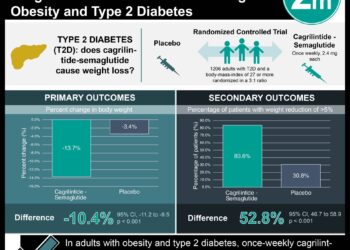High-fiber diet induces weight loss comparable to AHA multicomponent diet
1. After 1 year, patients with metabolic syndrome who followed the American Heart Association (AHA) diet lost only 0.6 kg more on average than patients who followed a diet high in fiber.
Evidence Rating Level: 1 (Excellent)
Study Rundown: The metabolic syndrome affects millions of Americans, and it has contributed to the rise of diseases such as type 2 diabetes and cardiovascular disease. To combat this, the American Heart Association (AHA) provides several dietary guidelines to aid in weight-loss, lower blood sugar, and mitigate other risk factors for the metabolic syndrome. Despite this, the AHA diet can often be too restrictive or complicated for patients, making its implementation practically challenging. This randomized, controlled trial examined whether focusing on one dietary guideline (i.e., increasing daily fiber intake) would lead to a comparable reduction in weight. At 12 months, patients on the high-fiber diet had lost an average of 2.1 kg, while patients on the AHA diet had lost an average of 2.7 kg. This small difference between the groups suggests that a simple diet focused on improving one nutritional area can help patients achieve meaningful weight loss. However, this study’s generalizability may be limited, since it only examined patients from a Worcester, MA hospital system. In this group, made up of mostly white women, the fiber intake and dietary quality were already higher than the national average. Nevertheless, recommending a diet high in fiber may be an effective strategy in achieving weight-loss in patients with the metabolic syndrome.
Click to read the study today in the Annals of Internal Medicine
Relevant Reading: Obesity and metabolic syndrome: Potential benefit from specific nutritional components
In-Depth [randomized controlled trial]: In this study, 240 patients with metabolic syndrome from Worcester, MA were randomly assigned to either the AHA diet or the high-fiber diet. Patients who were excluded from the study included those who participated in any weight loss program or used weight loss medication, and those who had diabetes, polycystic ovary syndrome, pregnancy, an eating disorder or depression. The study’s primary outcome was weight loss at 12 months. At baseline, 3 months, 6 months and 12 months, patients had their height, weight and pertinent laboratory data measured. At 12 months, patients following the high-fiber diet lost an average of 2.1 kg (95%CI -2.9 to -1.3 kg), while patients following the AHA diet lost an average of 2.7 kg (95%CI -3.5 to -2.0 kg). The mean difference in weight loss between the groups was 0.6 kg (95%CI -0.5 to 1.7 kg). None of the 16 adverse events reported during the trial were attributed to either intervention.
Image: PD
©2015 2 Minute Medicine, Inc. All rights reserved. No works may be reproduced without expressed written consent from 2 Minute Medicine, Inc. Inquire about licensing here. No article should be construed as medical advice and is not intended as such by the authors or by 2 Minute Medicine, Inc.







